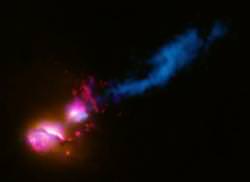Ouch, that’s going to leave a mark. A new photograph captured by NASA’s Chandra X-Ray Observatory shows a powerful jet blasting out of one galaxy, and colliding with another. As the jet tears through the galaxy, it could have serious implications for planetary formation, and trigger a wave of new star formation.
The image contains two galaxies, collectively known as 3C321, in orbit around one another. X-ray images from Chandra show that they both have supermassive black holes at their centres.
The black hole in the larger galaxy is actively feeding, and has an enormous jet of radiation and material blasting out into space. Unfortunately, the smaller galaxy has gotten caught right in the crossfire of this jet.
“We’ve seen many jets produced by black holes, but this is the first time we’ve seen one punch into another galaxy like we’re seeing here,” said Dan Evans, a scientist at the Harvard-Smithsonian Center for Astrophysics and leader of the study. “This jet could be causing all sorts of problems for the smaller galaxy it is pummeling.”
So what kinds of problems? For starters, the jet has a tremendous amount of radiation, especially high-energy X-rays and gamma-rays. An ongoing blast of this radiation could strip away planetary atmospheres and blow away newly forming stellar nurseries. In other cases, the jet could cause a cloud of gas and dust to collapse in the first place, setting the stage for new star formation.
Since the two galaxies are only 20,000 light years apart – the same distance of the Solar System to the middle of the Milky Way – the effect of the jet will be extreme. One bright part of the image shows where the jet is colliding with the galaxy, and then getting disrupted and deflected away.
This event is probably very short-lived. Astronomers estimate that the jet only began impacting the galaxy about a million years ago; a blink of the eye in cosmological terms.
Original Source: Chandra News Release


I wanted to ask when I looked in the south eastern sky last night I saw a star that appeared to be multiple colors did I truly see this or was I imagining that it was multiple colors.
I believe that most of the color changes seen in most celestial objects are indeed caused by our dense atmosphere. You probably would not see those multiple colors in an image taken from one of the orbiting telescopes.
bobi
Ahh…this is all made up! My tiny little mind can’t even comprehend what’s happening in our earthly universe right now, let alone all of the other great stuff that Universe Today brings to me every few (earth) days.
Bump yourself (U.T.) on providing us with what’s been going on outside the here and now. I’m guessing that the weather on a few of these galaxies is rougher than what we have here…even in Wisconsin.